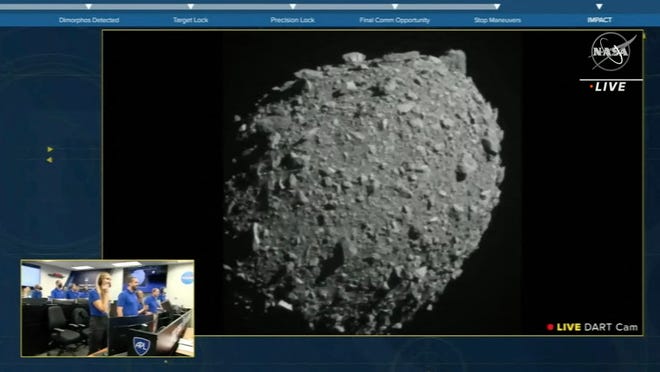Mission complete.
NASA successfully crashed a spacecraft into an asteroid Monday, marking a win for the agency’s plan for when a devastating asteroid should ever threaten humanity.
The 1,260-pound Double Asteroid Redirection Test spacecraft, or DART, collided with the estimated 11 billion pound, 520-foot long asteroid Dimorphos at 14,000 miles per hour close to 7 million miles from Earth. The spacecraft hit about 55 feet from the asteroid’s center.
The spacecraft had launched its camera and a shoebox-size companion, LICIACube, over a week ago to photograph the mission, which confirmed the impact.
“This was a really hard technology demonstration to hit a small asteroid we’ve never seen before, and do it in such spectacular fashion,” Nancy Chabot, planetary scientist and mission team leader at Johns Hopkins University, said after the impact.
The completed mission culminates a 10-month-long journey for DART, which cost $325 million. The asteroid orbits a larger one named Didymos, and the two were chosen because they don’t pose any threat to Earth.
“There was a lot of innovation and creativity that went into this mission, and I believe it’s going to teach us how one day to protect our own planet from an incoming asteroid,” said NASA Administrator Bill Nelson. “We are showing that planetary defense is a global endeavor, and it is very possible to save our planet.”
VISUAL EXPLAINER: Go inside NASA’s plan to crash the DART spacecraft into an asteroid
The DART team said no adjustments were needed on the mission and it went down “straight down the middle of what our expectations were.”
While DART successfully hit Dimorphos, NASA won’t know for weeks – possibly months – about the collision effects.
“Some things will likely come out in even days, maybe weeks,” mission systems engineer Elena Adams told reporters following the impact. “But I would say for the quantitative full answer, a couple of months.”
The agency’s goal was not to destroy the asteroid, but rather shift its orbit around about Didymos enough that it changes both of their trajectories. Dimorphos completes an orbit around Didymos in 11 hours and 55 minutes; NASA hopes the collision shortens its orbit by 10 minutes.
But changing an asteroid’s orbit by just 1% could be enough if a destructive one were headed towards Earth, NASA says. Currently, there are nearly 30,000 near-Earth objects in our solar system, according to NASA, meaning they come within 120.8 million miles of our planet. Over 10,000 of near-Earth objects them around the same size as Dimorphos.
Planetary defense experts prefer nudging a threatening asteroid or comet out of the way, given enough lead time, rather than blowing it up and creating multiple pieces that could rain down on Earth. Multiple impactors might be needed for big space rocks or a combination of impactors and so-called gravity tractors, not-yet-invented devices that would use their own gravity to pull an asteroid into a safer orbit.
While no asteroids of that size are expected to hit Earth in the next 100 years, only 40% of those asteroids have been discovered as of October 2021, NASA says. Fewer than 1% of the millions of smaller asteroids, capable of widespread injuries, are known.
But for now, astronomers say humanity should feel safe.
“Our first planetary defense test was a success,” Adams said. “Earthlings should sleep better.”
Contributing: Associated Press
Follow Jordan Mendoza on Twitter: @jordan_mendoza5.


